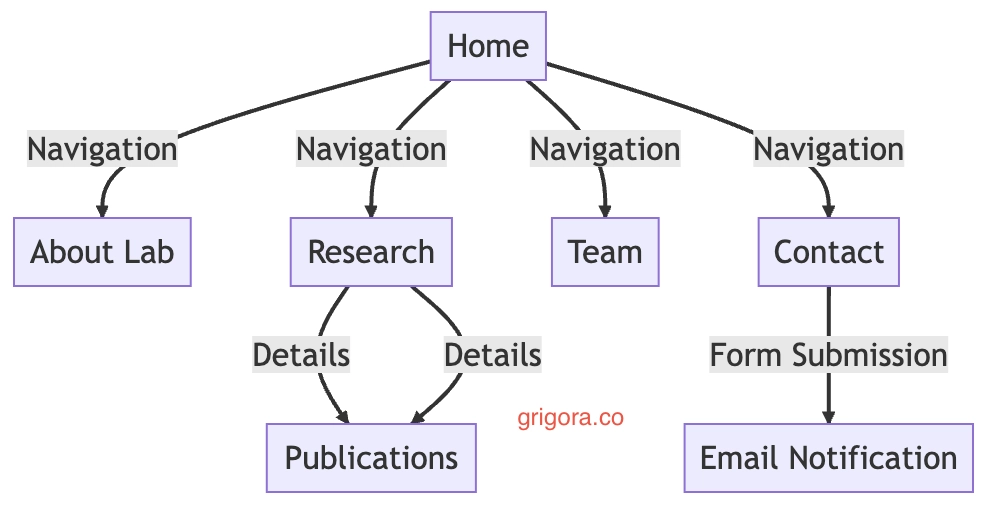Introduction
Understanding the Importance of a Lab Website
In today’s digitally connected world, having a digital presence is no longer a luxury but a necessity. This holds true for various sectors, including laboratories. Whether it’s a research lab, medical lab, or educational lab, a website serves as a vital tool to showcase the services, research, and achievements to a broader audience.
The Need for a Digital Presence in Laboratories
Laboratories are hubs of innovation, research, and scientific exploration. They contribute significantly to advancements in various fields, such as medicine, technology, and education. Without a digital presence, the reach of these contributions remains limited. A lab website acts as a window to the world, allowing scientists, researchers, students, and even the general public to access information, resources, and services offered by the lab.
It helps in building a global network, attracting potential collaborators, and even securing funding for research projects. A digital presence is essential for expanding the lab’s reach and impact.
Showcasing Services, Research, and Achievements
A lab website is not just a digital brochure but a dynamic platform that can be used to highlight the lab’s services, ongoing research projects, publications, team members’ profiles, and significant achievements. It can host a variety of content formats, including videos, images, research papers, and blog posts, providing a comprehensive view of the lab’s work.
This not only builds credibility but also fosters engagement with various stakeholders, including potential clients, collaborators, students, and donors. Showcasing the lab’s work through a well-designed website enhances visibility and credibility.
Identifying the Target Audience
Researchers, Students, Industry Professionals, and the General Public
A lab website is not just for scientists and researchers. It caters to a diverse audience, including researchers, students, industry professionals, and even the general public. Understanding the needs and interests of these different groups is crucial in designing a website that resonates with all.
Tailoring Content to Meet Diverse Needs
Each segment of the audience has unique needs and expectations. For example:
Researchers may look for detailed information on ongoing projects, publications, and collaboration opportunities.
Students might be interested in educational resources, internship opportunities, and insights into lab work.
Industry professionals could seek services, partnerships, and technological innovations.
The general public may want to understand the lab’s contributions to society, breakthroughs, and general scientific knowledge.
Tailoring the content to meet these diverse needs ensures that the website is relevant and engaging for all visitors.
Overview of the Guide
A Step-by-Step Guide to Creating a Lab Website
Creating a lab website is a systematic process that involves several key steps, from understanding the target audience to designing, developing, and maintaining the site. This guide will provide a step-by-step approach to creating a lab website that is both functional and visually appealing.
Identifying Your Lab Website Goals
Defining the Services and Research to Highlight
A lab website serves as a central hub for showcasing the laboratory’s work. It’s essential to define what to include, such as services offered, team profiles, publications, research projects, and more. This helps in creating a comprehensive and informative platform that reflects the lab’s identity and mission.
What to Include: Services, Team Profiles, Publications, etc.
Services: Detail the services offered by the lab, such as testing, analysis, consultation, etc.
Team Profiles: Introduce the team members, their expertise, and roles within the lab.
Publications: List the lab’s publications, research papers, and significant contributions to the scientific community.
Research Projects: Highlight ongoing and completed research projects, methodologies, findings, and impact.
Understanding Your Target Audience
Catering to Different Stakeholders
A lab website may cater to various stakeholders, including researchers, clients, students, funding agencies, and the public. Understanding the needs and expectations of these different groups ensures that the content and design of the website resonate with all. Tailoring the content to different stakeholders enhances engagement and relevance.
Setting Success Metrics
Goals and KPIs for the Website
Defining clear goals and Key Performance Indicators (KPIs) for the website is vital for measuring success. These might include metrics like user engagement, conversion rates, page views, time spent on the site, etc. Setting these metrics helps in evaluating the website’s performance and making necessary improvements.
Designing Your Lab Website
Selecting a Theme that Reflects Lab Branding
Choosing the right theme is crucial in conveying the lab’s brand and identity. The theme should align with the lab’s mission, values, and aesthetics. Grigora offers a wide range of customizable themes specifically designed for labs, allowing for a cohesive and professional look.
Grigora’s Customizable Themes for Labs
Grigora’s platform provides various themes that can be tailored to fit the lab’s unique branding. These themes are designed with laboratories in mind, incorporating elements that resonate with scientific and research-oriented audiences. Grigora’s themes are not only visually appealing but also functional, ensuring a seamless user experience.
Customizing the Layout for Easy Navigation
A well-structured layout ensures that visitors can easily navigate the site and find the information they need. The layout should be intuitive, with clear headings, menus, and links to essential pages.
Integrating Lab-Related Visuals
Visual content plays a vital role in enhancing the website’s appeal and conveying complex information. Images, videos, diagrams, and other visual elements can illustrate the lab’s work, equipment, facilities, and more.
Content Creation

Highlighting Your Lab Services and Research
Creating content that accurately and effectively highlights the lab’s services and research is essential. This includes detailed descriptions of the lab’s capabilities, equipment, research projects, and any services offered to other researchers or industries. The content should be clear, concise, and tailored to the needs of the target audience.
Creating Engaging Content for Various Audiences
A lab website may cater to various audiences, including researchers, students, industry professionals, funders, and the general public. Creating content that engages these diverse audiences requires understanding their specific interests and needs. Here are some tips and best practices for creating engaging content:
Understanding the Audience: Identify the different segments of the audience and what they are looking for. Tailor the content to address their specific questions and concerns.
Using Clear and Accessible Language: Avoid excessive jargon and technical language that may alienate non-specialist readers. Use clear and accessible language that conveys the information in an understandable way.
Incorporating Visuals: Use visuals such as images, charts, and videos to illustrate complex concepts and make the content more engaging.
Highlighting Key Takeaways: Use headings, bullet points, and other formatting tools to highlight key takeaways and make the content easy to scan.
Telling Stories: Share success stories, case studies, and testimonials to humanize the lab’s work and demonstrate its impact.
Promoting Your Lab Website
Promoting a lab website is crucial to reaching a wider audience and enhancing the visibility of the lab’s work, services, and achievements. Here’s how to effectively promote a lab website:
Social Media Strategies
Social media platforms are powerful tools for promoting a lab website. They allow labs to connect with a diverse audience, share updates, and engage with followers. Here’s how to leverage social media:
Creating Shareable Content: Post engaging content that encourages sharing, such as news, research highlights, events, and multimedia.
Engaging with Followers: Respond to comments, participate in relevant conversations, and build a community around the lab’s work.
Utilizing Hashtags and Tags: Use relevant hashtags and tag collaborators, funders, and other stakeholders to increase visibility.
Scheduling Regular Updates: Plan and schedule regular posts to keep followers informed and engaged.
Collaborating with Academic and Industry Partners
Collaboration with academic and industry partners can significantly boost the lab’s visibility and credibility. Here’s how to foster collaboration:
Highlighting Collaborations on the Website: Dedicate sections of the website to showcase collaborations, joint research projects, and partnerships.
Engaging in Joint Promotions: Collaborate with partners on joint promotions, such as co-hosting webinars, sharing each other’s content, and jointly announcing research findings.
Building Networks and Partnerships: Attend conferences, workshops, and networking events to build relationships with potential collaborators. Utilize platforms like LinkedIn to connect with industry professionals and academics.
Monetizing Opportunities for Your Lab Website
Monetizing a lab website can provide additional revenue streams and support the lab’s research, services, and outreach activities. Here’s how to explore monetizing opportunities:
Online Lab Consultations and Services
Many labs offer specialized consultations, testing services, or training workshops. These can be offered online through the lab’s website. Here’s how to set up online consultations and services:
Identifying Services to Offer Online: Determine which lab services can be offered online, such as consultations, training, testing, or data analysis.
Setting Up Online Booking: Implement an online booking system that allows clients to schedule appointments, register for workshops, or request specific services.
Providing Secure Payment Options: Ensure that the website offers secure payment options for clients to pay for services online.
Delivering Services Virtually: Utilize video conferencing tools, downloadable resources, or online platforms to deliver services virtually.
Selling Lab Products or Services
Labs may also have opportunities to sell products, such as lab equipment, reagents, software, or educational materials. Here’s how to set up an online store:
Listing Products or Services: Create detailed listings for each product or service, including descriptions, specifications, pricing, and images.
Managing Inventory and Orders: Implement inventory management and order processing systems to handle sales efficiently.
Offering Secure Checkout: Provide a secure checkout process with various payment options to accommodate different customers.
Analyzing and Improving Your Lab Website
A successful lab website requires continuous monitoring, analysis, and improvement. Understanding how users interact with the site, what content resonates with them, and where improvements can be made is essential for the website’s ongoing success. Here’s how to analyze and improve your lab website:
Tracking Website Performance
Monitoring the performance of your lab website is crucial to understand how users are engaging with the content, what pages are most visited, and where potential issues might be occurring. Here’s how to track website performance:
Setting Up Analytics: Implement tracking codes to monitor user behavior, page views, bounce rates, conversion rates, and other essential metrics.
Monitoring User Engagement: Analyze how users are interacting with the site, what content they are engaging with, and how long they are spending on different pages.
Identifying Issues and Opportunities: Regularly review analytics data to identify areas where the site may be underperforming or where opportunities for improvement exist.
Engaging with Users and Collecting Feedback
Engaging with users and collecting their feedback is essential to understand their needs, preferences, and any challenges they may be facing while using the site. Here’s how to engage with users and collect feedback:
Implementing Feedback Forms: Include feedback forms on the site to allow users to share their thoughts, questions, or concerns.
Conducting User Surveys: Regularly conduct user surveys to gather more in-depth insights into user needs and preferences.
Monitoring Social Media and Online Reviews: Keep an eye on social media mentions and online reviews to understand public perception and gather feedback.
Legal and Ethical Considerations for Your Lab Website
Creating and maintaining a lab website involves several legal and ethical considerations that must be carefully addressed. Ensuring compliance with relevant regulations and maintaining privacy and confidentiality are paramount. Here’s a detailed look at these aspects:
Compliance with Lab Regulations
Laboratories must adhere to various regulations and standards that govern their operations, research, and services. When creating a lab website, it’s essential to ensure that all content, representations, and claims align with these regulations. Here’s how to ensure compliance:
Understanding Relevant Regulations: Familiarize yourself with the laws and regulations that apply to your specific type of laboratory, whether it’s a medical lab, research lab, or other specialized facility.
Representing Services Accurately: Ensure that all descriptions of services, research, certifications, and accreditations are accurate and comply with relevant standards.
Providing Necessary Disclaimers: Include appropriate disclaimers and notices where required, such as limitations of certain services, legal notices, or any other regulatory requirements.
Privacy Policies and Client Confidentiality
Protecting the privacy of users and maintaining the confidentiality of any client or patient information is a critical legal and ethical obligation for labs. Here’s how to address privacy and confidentiality:
Creating a Comprehensive Privacy Policy: Develop a clear and transparent privacy policy that outlines how user information is collected, used, stored, and shared. Make this policy easily accessible on the website.
Implementing Robust Security Measures: Utilize strong security measures to protect any sensitive information collected through the website, such as contact details, appointment requests, or payment information.
Maintaining Confidentiality: Ensure that any client or patient information displayed or shared through the website is handled with the utmost confidentiality and in accordance with applicable privacy laws.
Grigora’s Comprehensive Solutions for Lab Websites
In the digital age, having a professional and functional website is essential for labs to showcase their services, research, and achievements. Grigora, with its innovative platform, offers a wide range of solutions tailored to meet the unique needs of lab websites. Here’s a detailed look at how Grigora can be a game-changer for your lab website:
Introduction to Grigora’s Features for Lab Websites
Grigora’s platform is designed to empower labs to create stunning websites with ease. Here’s an overview of the key features:
Customizable Themes: Grigora offers a variety of themes that can be tailored to reflect the branding and aesthetics of your lab. Whether you want a sleek, modern design or a more traditional look, Grigora has you covered.
User-Friendly Interface: With Grigora’s intuitive interface, you don’t need to be a tech expert to build a professional website. Its drag-and-drop functionality makes it easy to add, arrange, and customize elements on your site.
Robust Security Measures: Grigora understands the importance of data security, especially for labs that may handle sensitive information. Its platform includes robust security features to protect your site and user data.
SEO and Mobile Responsiveness: Grigora’s platform is designed to enhance your site’s visibility on search engines and ensure a seamless experience across various devices. This helps in reaching a wider audience and improving user engagement.
E-commerce and Online Consultation Features: For labs that offer products or online consultations, Grigora provides e-commerce capabilities and tools to facilitate online appointments and services.
Analytics and Performance Tracking: Grigora’s analytics tools provide insights into your website’s performance, helping you understand user behavior, track goals, and make informed decisions to enhance your site.
Success Stories of Lab Websites Using Grigora
Grigora’s platform has been instrumental in the success of various lab websites. Here are some real-world examples:
Research Lab Showcasing Breakthroughs: A renowned research lab used Grigora to create a dynamic website that highlights its groundbreaking research, publications, and collaborations. Grigora’s customizable features allowed the lab to present complex scientific content in an engaging and accessible manner.
Medical Lab Enhancing Patient Engagement: A medical lab leveraged Grigora’s user-friendly interface and security features to create a website that facilitates online appointments, provides test results, and offers educational resources for patients. Grigora’s platform enabled the lab to enhance patient engagement and satisfaction.
Educational Lab Connecting with Students: An educational lab utilized Grigora’s platform to build a website that serves as a hub for students, researchers, and educators. From showcasing projects and resources to facilitating online learning and collaboration, Grigora’s features supported the lab’s educational mission.
FAQs on How to Make a Lab Website
What content should I include on my lab website?
Your lab website should highlight services, team profiles, research, publications, and contact information. It may also include a blog, testimonials, and online booking options.
How can I customize my lab website according to my branding?
Most website platforms offer customization options for themes, colors, fonts, and layouts. Grigora provides extensive customization to align with your branding.
Can I manage my lab website without technical skills?
Yes, many platforms are designed for users without coding knowledge. Grigora’s drag-and-drop interface, for example, makes it easy to manage your site without technical expertise.
How can I make my lab website user-friendly?
User-friendliness can be achieved through intuitive navigation, mobile responsiveness, and clear content layout.
What are the best practices for lab website SEO?
Effective SEO practices include using relevant keywords, optimizing meta tags, creating quality content, and ensuring mobile-friendliness. Some platforms, including Grigora, offer built-in SEO tools.
Can I integrate online lab appointment scheduling on my website?
Yes, many website platforms allow integration with online appointment scheduling tools.
Conclusion
Key Takeaways
Creating a lab website is an essential step in showcasing your services, research, and achievements to a broader audience. The process involves several critical stages, including:
Identifying Goals and Target Audience: Understanding what you want to achieve and who you want to reach is foundational.
Design and Content Creation: Selecting a theme that reflects your lab’s branding and creating engaging content are vital for user engagement.
Promotion and Monetization: Effective promotion and potential monetization strategies can enhance your site’s reach and functionality.
Analysis and Improvement: Regular tracking and feedback collection help in continuous improvement.
Legal Compliance: Ensuring adherence to regulations and privacy policies is crucial.
Next Steps in Your Lab Website Journey
With the insights gained from this guide, you are well-equipped to embark on your lab website creation journey. Here’s what you can do next:
Evaluate Your Needs: Assess what you want your website to achieve and who you want to reach.
Choose the Right Platform: Consider platforms like Grigora that offer specialized features for labs.
Design and Develop Your Site: Utilize the tools and guidelines provided to build a user-friendly and visually appealing site.
Promote and Monitor Your Site: Implement the strategies discussed to promote your site and keep track of its performance.
Remember, creating a lab website is not a one-time task but an ongoing process of engagement, improvement, and adaptation to the evolving needs of your audience and the field. Whether you’re showcasing groundbreaking research or offering specialized lab services, a well-designed website serves as a dynamic platform to connect, inform, and inspire.
With platforms like Grigora, even those without technical expertise can create and manage a professional lab website, unlocking new opportunities for collaboration, visibility, and impact in the scientific community.



